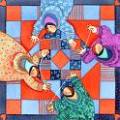
Quilting Reviews
|
Choosing And Preparing Fabric
Choosing And Preparing Fabric
Choosing fabric for a quilting project can be as much fun as doing the project itself. Even if to quilters choose the same quilt pattern, different choices of fabric will make each quilt unique. Most quilter's prefer using fabric that is 100 % cotton because they are easier to sew, mark, press and hand quilt. If you are shopping for fabric in a quilt shop you will rarely find fabric that is not pure cotton. Fabrics will also probably be arranged according to colors and print types.
With more experience fabrics other than cotton may be added for variety. Not all fabrics are suitable however. If you are using an unusual fabric for the first time, or want to use different types of fabrics together, try a small test block first. Fabrics of a medium density, with an even weave work well. Loosely woven fabrics are prone to distortion, as are stretch fabrics. Silk, lightweight wool and some plastics may be used with experience.
Both the color and tone of the fabric you choose will influence the overall effect of the pattern that you choose. Tone may be used to create depth and interest with greater effect than when using color alone. Good planning is necessary to achieve the desired look.
Color is greatly affected by the colors around it. Using contrasting colors will make pieces of a quilt block stand out from each other. Combing certain warm colors such as reds, yellows and oranges, in the same quilt block as cool colors like blues, greens or violets, will make them look more vivid.
Combining fabrics with various print scales and styles can add visual texture to your quilt. Interesting visual effects may also be achieved by using colors of graduated values. Printed cotton fabrics are available in many designs and styles including batiks, homespun plaids and florals, tiny-grained prints that look like solids, reproduction prints, and soft flannels. Solid-color fabrics come in just about every color, shade and tint that you can imagine.
Quilt blocks made from fabrics of the same or various shades of one color, but of contrasting textures can create pleasing results. Fabrics with a nap such as velvet, or fabrics with sheen like taffeta also provide interest.
Whatever fabric you choose for your quilting project, you must prepare it properly before you begin. Most cotton fabrics shrink when they are washed and dried. If you do not preshrink your fabric before you make your quilt, the fabrics may pucker at the stitching lines and the finished product may shrink in size the first time it is washed.
To prevent this wash all fabrics first in a washing machine on a short gentle cycle. Use cool or warm but never hot water. You may use a mild detergent, but it is not necessary unless the fabric is soiled. Wash like colors together in case they are not colorfast. Machine dry the fabric and press it with an iron. You are now ready to begin your project.
 |
 |
 |
Add Life To Your Quilting With Embroidery
How To Choose The Right Batting
How To Use Stencils For Quilting
More Quilting Articles
Essential Supplies For Quilting
... for your new craft. A huge part of the fun of starting a new hobby is learning about what kinds of supplies you will need to accomplish it. There's something so satisfying about working with tools and supplies. While the craft of quilting doesn't technically require much more than a good sewing machine, ...
... company maintains that these small shops hire employees who understand the craft of quilting and the passion that quilters have for it. Many quilting shops are grateful to the support RJR has shown to small businesses. Another reason for the success of RJR Fabrics is the quality of their designers. Among ...
How To Use Templates In Quilting
... templates. Usually made from sturdy clear acrylic, and designed to be used over and over again, templates make marking and cutting pieces for a quilt block a breeze. Templates generally have seam line and other markings on them for the convenience of quilters. The best templates are laser cut to ensure ...
Making Sense OF Quilt Patterns
... Variations of this pattern include the Grecian Design, the Greek Cross and the Wrench. There are three major pattern pieces: a 4 inch square, a 2x4 inch rectangle and a large triangle. The Log Cabin design is probably the most well recognized quilt pattern. It is made of strips of fabric sewn together ...

|
| Copyright © 2006-2012 Internet Marketing Tools, All Rights Reserved |